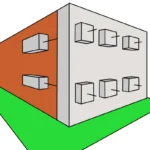Green roofs, also known as living roofs or rooftop gardens, have gained popularity in recent years due to their ability to enhance the quality of the urban environment and provide a range of benefits for both people and nature. These vegetated surfaces are not only aesthetically pleasing but also play a crucial role in mitigating the negative effects of cities on climate, biodiversity, and public health.
What are Green Roofs?
Green roofs are systems that involve covering roofs or urban surfaces with vegetation, either by planting directly in the substrate or by installing prefabricated systems containing substrate and plants. These green surfaces can vary in size, from small terrace gardens to extensive areas on skyscrapers and commercial buildings. The vegetation used in green roofs can be of different types, such as grass, herbs, shrubs, or even trees, depending on the purpose and design of the project.
Benefits of Green Roofs
These roofs offer a range of benefits, the foundations of which lie in natural processes that occur on these vegetated surfaces. Below, we will explore how these processes make some of their benefits possible.
Mitigation of Urban Heat:
Cities often experience higher temperatures due to the “urban heat island” effect. Green roofs help reduce this effect by providing a layer of vegetation that absorbs and reflects less heat than traditional impermeable surfaces, such as concrete and asphalt. This benefit is possible through:
Shade and Evapotranspiration: Plants on green roofs provide shade to the surface, reducing direct absorption of solar radiation. Additionally, through evapotranspiration, plants release water in the form of vapor into the air, cooling the surrounding surface and reducing ambient temperature.
Reflection of Solar Radiation: Vegetation on green roofs reflects part of the solar radiation instead of absorbing it, decreasing the amount of heat absorbed by the surface and contributing to the mitigation of urban heat.
Improvement of Air Quality:
Plants on green roofs act as natural filters by trapping particles and atmospheric pollutants, such as carbon dioxide (CO2), nitrogen oxides (NOx), and volatile organic compounds (VOCs). This is possible through:
Particle Filtration: Plants on green roofs act as natural filters by trapping dust particles and air pollutants, reducing the concentration of particles in the environment.
CO2 Absorption: During photosynthesis, plants absorb carbon dioxide (CO2) from the atmosphere, helping to reduce the amount of this greenhouse gas in the air.
Reduction of Atmospheric Pollutants: Plants can also absorb nitrogen oxides (NOx) and volatile organic compounds (VOCs), two common pollutants in urban areas.
Acoustic Isolation:
Green roofs reduce noise in urban environments by acting as natural acoustic isolation barriers. Isolation occurs due to:
Sound Absorption: Vegetation on green roofs acts as a natural sound absorber. Leaves and substrate layers absorb some sound waves, reducing noise propagation.
Sound Diffusion: The rough and textured surfaces of plants can diffuse sound, causing sound waves to bounce in different directions instead of reflecting directly into surrounding areas, thereby reducing noise exposure.
Rainwater Retention:
Another key benefit of green roofs is their ability to retain rainwater. This reduces runoff and the burden on sewage systems, helping to prevent flooding in urban areas and conserve water, an increasingly scarce resource. For water retention to be possible:
Absorption and Retention: The substrate of green roofs has the capacity to absorb and retain rainwater, reducing the amount of water flowing into sewage systems and preventing floods.
Gradual Release: Over time, the water retained in the substrate is released gradually as plants absorb and transpire it, providing a sustainable source of moisture for vegetation and preventing peak runoff.
Biodiversity Promotion:
Green roofs can also serve as habitats for urban fauna, promoting biodiversity in urban areas where natural green spaces are limited. This occurs because green roofs serve as:
Habitat for Fauna: Green roofs can serve as habitats for a variety of urban fauna, promoting biodiversity.
Food and Shelter: Plants provide food and shelter for fauna, contributing to the life cycle of many species and supporting local ecology.
Types of Green Roofs
There are various types of green roofs, each with its own characteristics and applications. Some of the most common types include:
Extensive Green Roofs
Extensive green roofs are low-maintenance systems that generally consist of resilient and slow-growing vegetation, such as succulents and herbs. They are ideal for roofs with gentle slopes and are not suitable for frequent human access. These roofs are lightweight and require minimal watering and fertilization.
Intensive Green Roofs
Intensive green roofs are more elaborate and can accommodate a wider variety of plants, including trees and shrubs. They are suitable for areas with human access and can include features such as pathways, benches, and resting areas. However, they require more maintenance and watering than extensive green roofs.
Semi-Intensive Green Roofs
Semi-intensive green roofs are a middle ground between extensive and intensive roofs. They typically include a combination of resilient and faster-growing plants and can accommodate limited human access areas. They require moderate maintenance and regular watering.
Green Roof Design

Green roof design is a complex process that involves several important considerations to ensure its effectiveness, durability, and long-term sustainability. Careful attention at each stage of the design is essential to ensure that the green roof meets its goals and integrates effectively into the urban environment. Below, we will delve into the key aspects and detailed considerations of green roof design:
Site Assessment
Before beginning the design of a green roof, it is crucial to conduct a comprehensive site assessment. This involves analyzing a range of factors, including:
Roof Load Capacity: The green roof must be compatible with the load capacity of the roof or surface on which it will be installed. Structural studies should be conducted to determine the strength and load capacity of the substrate and vegetation, as well as any additional elements added, such as pathways or furniture.
Sunlight: The amount of sunlight the site receives is a critical factor in plant selection and the effectiveness of the green roof. It is important to conduct a detailed analysis to identify shaded and sun-exposed areas and select suitable plants accordingly.
Human Access: The accessibility of the green roof is another important aspect of the design. If people are expected to walk or use the space, paths, resting areas, and other elements ensuring a safe and comfortable experience should be incorporated.
Drainage Needs: Adequate drainage is essential to prevent water accumulation on the green roof. This includes the installation of efficient drainage systems, such as drainage layers and gutters.
Plant and Substrate Selection
Choosing the right plants and substrate is a fundamental step in designing a green roof. Additional considerations include:
Local Conditions Resistance: Selected plants must be resistant to the specific conditions of the site, including exposure to sun, wind, and dryness. Choosing native plants can be beneficial, as they are often better suited to the local environment.
Maintenance Level: The maintenance level required by the plants is an important factor. Varieties should be selected that match the level of care the owner or manager of the green roof can provide.
Vegetal Diversity: Incorporating a variety of plant species can enhance biodiversity on the green roof and provide a more attractive appearance. However, it is important to consider the compatibility of these plants in terms of light and water needs.
Substrate: The substrate is the medium in which plants will grow It should provide good drainage, water retention, and nutrients for the plants. The choice of substrate should be based on the needs of the plants and the site conditions.
Waterproofing and Drainage System
Proper waterproofing and an efficient drainage system are essential to prevent water leakage into the building and ensure the green roof remains healthy. Some key points to consider are:
Waterproofing: High-quality waterproof membranes should be installed to prevent water leakage into the building structure. The choice of waterproofing material should be based on durability and resistance to plant root penetration.
Drainage Layers: Drainage layers, such as geotextiles and gravel layers, are used to evacuate excess water and prevent substrate saturation. These layers should be designed to ensure efficient drainage without blockages.
Maintenance
Regular maintenance is essential to ensure that the green roof remains healthy and attractive over time. This includes activities such as:
Watering: A watering schedule should be established to meet the needs of the plants, considering changing seasons and weather conditions.
Pruning and Plant Maintenance: Regular pruning and maintenance are essential to control plant growth, remove dead leaves, and promote the overall health of the vegetation.
Weed Control: The appearance of weeds can compete with desired plants and negatively affect the aesthetics of the green roof. Regular weed control measures are important.
Monitoring and Evaluation
Continuous monitoring and evaluation are key components of green roof design. This requires monitoring the health of plants, substrate quality, and the effectiveness of the drainage system. Adjustments may be necessary over time to optimize performance and address any issues that arise.
Applications of Green Roofs
Green roofs have a wide variety of applications in urban environments, including:
Residential: In private residences, green roofs can create attractive and functional outdoor spaces, improve energy efficiency, and provide a refuge for urban fauna.
Commercial: Commercial buildings can use green roofs to enhance the company’s image, reduce energy costs, and create rest areas for employees.
Institutional: Schools, hospitals, and other institutions can incorporate green roofs to improve the quality of the environment and provide green spaces for the community.
Infrastructure: Green roofs can also be integrated into urban infrastructure, such as train stations, bus stops, and bridges, to enhance aesthetics and sustainability.
Challenges and Considerations

Designing green roofs is an exciting process but comes with challenges and considerations that must be carefully addressed to ensure the success of the project. Below, we will delve into some of the most important challenges and considerations in green roof design:
Initial Cost
Challenge: One of the main challenges in green roof design is the initial cost. Installing waterproofing systems, drainage, substrate, and vegetation can be expensive and may require a significant investment.
Consideration: It is essential to consider the cost as a long-term investment. As the demand for green roofs increases, costs tend to decrease. Additionally, it is crucial to evaluate the long-term benefits in terms of energy savings, improved air quality, and increased property value.
Continuous Maintenance
Challenge: Green roofs require regular maintenance to ensure that plants remain healthy and the structure stays in good condition. Maintenance may include watering, pruning, weed control, and fertilization.
Consideration: When designing a green roof, it is important to plan for maintenance from the beginning. This involves establishing a maintenance schedule and ensuring that the owner or manager has the necessary resources and training to carry it out.
Plant and Substrate Selection
Challenge: Incorrect selection of plants and substrate can lead to plant health problems, uneven growth, or even plant death. Additionally, some plants may have invasive root systems that can damage waterproofing.
Consideration: Conducting a careful site analysis and selecting suitable plants and substrate is essential. This should be based on local conditions, exposure to sun, resistance to extreme weather conditions, and compatibility with waterproofing layers.
Drainage System
Challenge: An inadequate drainage system can lead to waterlogging or water accumulation on the green roof, which can damage vegetation and the building structure.
Consideration: Designing and installing an effective drainage system that includes appropriate drainage layers, drainage channels, and rainwater evacuation systems is crucial. Regular monitoring of the drainage system is essential to detect and address issues in a timely manner.
Durability and Root Resistance
Challenge: Plant roots can pose a threat to the integrity of waterproofing and other building structures. If roots penetrate the waterproofing membrane, they can cause water leaks.
Consideration: To address this challenge, root barriers and root-resistant waterproofing membranes can be used. It is important to choose high-quality materials that are durable and resistant to root penetration.
Risk Assessment
Challenge: It is important to consider potential risks, such as intense storms, strong winds, or fires, which can affect the green roof and its urban environment.
Consideration: Risk assessments should be conducted to identify possible threats and take preventive measures. This may include selecting plants resistant to strong winds, installing emergency irrigation systems, and planning fire protection measures.
Local Regulations and Codes
Challenge: Local regulations and building codes can vary significantly from one place to another and can influence green roof design.
Consideration: It is essential to be aware of and comply with local regulations and permit requirements. Working closely with local authorities can facilitate the process and ensure compliance with regulations.
Conclusion
Green roofs represent an innovative and sustainable solution to improve the quality of life in increasingly dense urban environments. With benefits ranging from heat mitigation and improved air quality to the promotion of biodiversity, these vegetated surfaces play a significant role in creating greener and more livable cities. As awareness of the importance of sustainability grows, green roofs are likely to become a common feature in the urban landscape of the future.







Related
Gravity Retaining Walls
What are Anchored Retaining Walls?
Methods for Paver Calculation – Civil Engineering